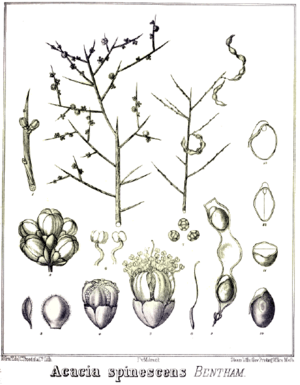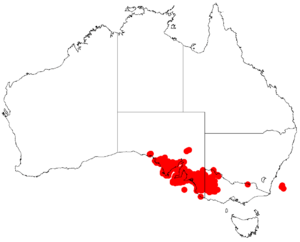Spiny wattle facts for kids
Quick facts for kids Spiny wattle |
|
|---|---|
 |
|
| Sketches of Acacia spinescens from Iconography of Australian species of Acacia and cognate genera | |
| Scientific classification | |
| Genus: |
Acacia
|
| Species: |
spinescens
|
 |
|
| Occurrence data from AVH | |
The Spiny Wattle, also known as Acacia spinescens, is a type of shrub. It belongs to the large group of plants called Acacia, which are often known as wattles. This plant naturally grows in parts of New South Wales, South Australia, and Victoria in Australia.
What Does the Spiny Wattle Look Like?
The Spiny Wattle is a shrub that stands upright and has many branches. It usually grows to be about 0.5 to 1 metre (2 to 3 ft) tall. Its branches are stiff, green, and spiky, with yellow lines running along them.
- Leaves: This plant usually has very few leaves, or sometimes no leaves at all, except for a few at the bottom. Any leaves it does have are curved or hooked, and you can see a clear line down the middle.
- Flowers: The Spiny Wattle flowers between July and October. It produces single, bright yellow, round flower-heads.
- Seed Pods: After flowering, it forms dark brown seed pods. These pods are usually curved and often twisted. Each pod is about 30 millimetres (1.2 in) long and 3.5 mm (0.1 in) wide.
- Seeds: Inside the pods are hard, dark brown seeds. They are shaped like an oval, with each seed being about 3.5 mm (0.1 in) long and 2.5 mm (0.1 in) wide.
How Did the Spiny Wattle Get Its Name?
The scientific name for the Spiny Wattle is Acacia spinescens. The word spinescens comes from two Latin words:
- spina, which means "thorn" or "spine"
- escens, which means "beginning"
So, the name refers to the plant's branches, which end in a sharp point or spine.
The Spiny Wattle was officially named by a person called George Bentham in 1842. He described it in a book titled Notes on Mimoseae, with a synopsis of species, which was part of William Jackson Hooker's London Journal of Botany.
Where Does the Spiny Wattle Grow?
The Spiny Wattle can be found in many different types of soil and natural environments. It often grows alongside other plant species.
- South Australia: In South Australia, you can find it in the southern areas. Its range stretches from the Great Victoria Desert in the west all the way to the border with Victoria in the east. It also grows on Kangaroo Island.
- Victoria: In Victoria, this plant is only found in the eastern parts of the state. It grows in areas known as the mallee and goldfields regions.
- New South Wales: From Victoria, its habitat extends north into the southwestern parts of New South Wales.

